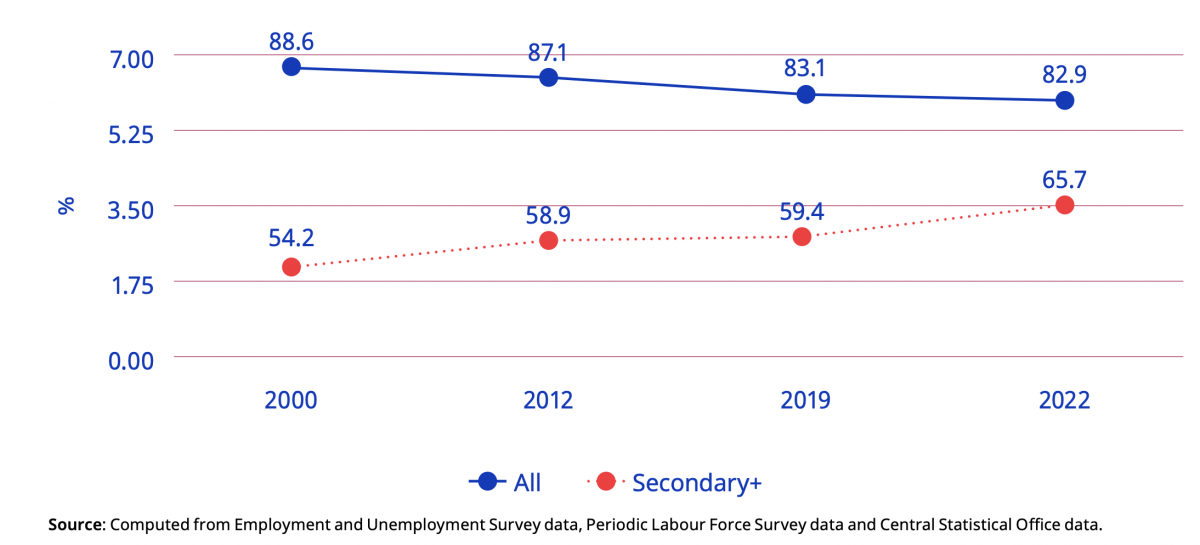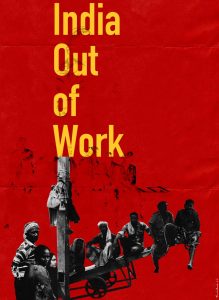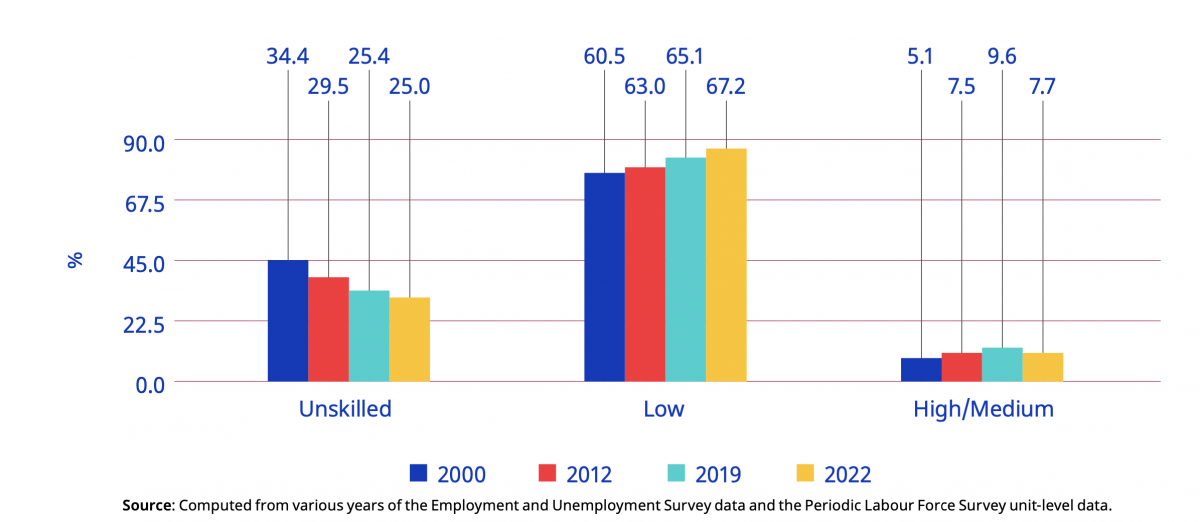Youth Made Up 82.9% of India's Unemployed Population in 2022: ILO
Ahead of the Lok Sabha election, the crisis of unemployment unites India as few things do. Why are important sections of India out of work? How do unemployed Indians live? Why is the work available not enough to earn a livelihood? How do Indians secure employment? How long is the wait? With India out of work, The Wire unveils a series that explores one of the most important poll issues of our time.
New Delhi: Unemployment in India is predominantly a problem among youths, especially young people with a secondary or higher level of education, and it has intensified over time, according to a a recently released International Labour Organisation report.
In 2022, the share of unemployed youths in the total unemployed population was 82.9%. Further, the report mentioned that the share of educated youths among all unemployed people increased 11.5% from 54.2% in 2000 to 65.7% in 2022. Among the educated (secondary level or higher) unemployed youths, women accounted for a larger share (76.7%) than men (62.2%).
The report titled India Employment Report 2024: Youth employment, education and skills underlines that the problem of unemployment in India has become increasingly concentrated among the youth, especially educated youths and women in urban areas.

Share of unemployed educated youths (secondary or higher) in total unemployed persons (UPSS), 2000, 2012, 2019 and 2022 (%). Photo: India Employment Report 2024: Youth employment, education and skills (ILO)
The report pointed out that in 2022, the unemployment rate among youths was six times greater for those who had completed secondary education or higher (18.4%) and nine times higher for graduates27 (29.1%) than for persons who could not read or write (3.4%). Moreover, this trend was higher among educated young women (21.4%) than men (17.5%), especially among female graduates (34.5%), compared to men (26.4%) with similar qualifications. In general, the unemployment rate among educated youths grew from 23.9% in 2000 to 30.8% in 2019, however, it fell sharply to 18.4% in 2022.

Illustration: Pariplab Chakraborty. Photo: Intifada P. Basheer and Azam Abbas
Another factor highlighted by the report is that the quality and condition of employment among youths are poorer compared with the older cohort, although more youths are in industry and services. They are more likely to be engaged in self-employed unpaid family work and casual wage work. They are also more likely to be involved in no-skill and low-skill informal work, which typically offers lower wages or earnings.
Nearly, 82% of the workforce engages in the informal sector, and nearly 90% is informally employed, the report underlined. Further, a significant proportion of regular workers in the formal sector are informal — “informalisation” of the formal sector is a visible development — this trend was accentuated between 2019 and 2022, as reflected in the decline in the proportion of regular formal workers or better-quality work.
The ILO report noted that the persistence of self-employment is a feature of the Indian labour market, and self-employment continues to constitute about half of total employment in the economy, which is one of the highest in the world.
However, self-employment is not necessarily a positive trend in the Indian labour market since the report highlighted a considerable gap in wages and earnings. In 2022, regular workers earned an average of Rs 19,010 per month, followed by self-employed individuals earning Rs 11,973 and casual workers earning Rs 8,267. There was a gender gap in the average monthly earnings as well, with self-employed individuals having the largest gender gap in earnings, followed by casual workers and regular salaried workers, the report cited.
Labour force participation rate and gender
According to the study, the labour force participation rate (LFPR) among youths has been declining, with a reduction from 54% in 2000 to 42% in 2022, and the decline has been sharper among youths aged 15-19 compared to youths aged 20-24 and 25-29. The LFPR in India for individuals aged 15 years and older was 55.2% in 2022, which was lower than the world average of 59.8%.
It consistently declined over the past two decades, from 61.6% in 2000 to 50.2% in 2019, before increasing to 55.2% in 2022. The worker population ratio also exhibited a similar trend, declining from 60.2% in 2000 to 47.3% in 2019 before increasing to 52.9% in 2022, the report mentioned.

Labour force participation rate, worker population ratio and unemployment rate (UPSS) among persons aged 15+ (rural and urban combined), 2000, 2012, 2019 and 2022 (%). Photo: India Employment Report 2024: Youth employment, education and skills (ILO)
Moreover, there is a significant gender gap in the labour market. In 2022, the LFPR of young men stood at 61.2% compared to young women at 21.7%, and the gender gap was similar in both rural and urban areas.
The report also highlighted that the female LFPR declined sharply (by 14.4 percentage points) when compared with the male counterparts (by 8.1 percentage points) between 2000 and 2019. However, this trend reversed between 2019 and 2022, with a much greater increase in the female LFPR (by 8.3 percentage points) than in the male LFPR (by 1.7 percentage points).
In 2022, women’s LFPR stands at 32.8% which is around 2.3 times lower than the rate for men which is at 77.2%. Overall, India’s low LFPR is largely attributed to the low female LFPR, which is much lower than the world average for 2022 — 47.3% — but higher than the South Asian average of 24.8% (ILO 2023).
Further, the report pointed out that the LFPR declined significantly more in rural areas (by 14.1 percentage points) than in urban areas (by 3.5 percentage points) between 2000 and 2019. However, this pattern reversed between 2019 and 2022, with a much higher increase in the LFPR in rural areas (by 6 percentage points) than in urban areas (by 2.1 percentage points).
Also read: Low-Paying Apprenticeships, False Promises, Convenient Narratives: The Skill India Dream
Skills vs employment
The share of high- and medium-skill jobs increased from 5.1% in 2000 to 9.6% in 2019, while low-skill jobs increased from 60.5% to 65.1%.
Simultaneously, the share of unskilled jobs decreased from 34.4% in 2000 to 25% in 2022. These trends suggest a rise in high- and medium-skill jobs and a decline in no-skill or routine-type jobs. However, the trend shifted, with a consistent increase in low-skill jobs and a decrease in high- and medium-skill jobs between 2019 and 2022.
The share of high- and medium-skill jobs increased from 5.1% in 2000 to 9.6% in 2019, while low-skill jobs increased from 60.5% to 65.1% in the same period.

Occupation-based skill structure of employment (UPSS, aged 15+), 2000, 2012, 2019 and 2022 (%). Photo: India Employment Report 2024: Youth employment, education and skills (ILO)
Most of the employment growth in the tertiary sectors occurred in business, finance, real estate, health, education, communications and hotels and restaurants between 2000 and 2019.
General employment challenges
The report pointed out that the gap in earnings across gender and other social categories has declined over the years but the broad socio-economic hierarchies in access to employment, education and earnings persists.
Despite affirmative action and targeted policies, the Scheduled Castes and Scheduled Tribes still lag in terms of access to better jobs. Scheduled Castes and Scheduled Tribes have greater participation in work due to economic necessity but engaged more in low-paid temporary casual wage work and informal employment.
Moreover, the report pointed out that the geographical distribution of employment characteristics shows that the share of regular, formal and organised sector employment and high-skill jobs is significantly larger in the South, West and North-East regions than in the East and Central regions in 2022.
As per the report, there are five general employment challenges.
First, India is experiencing a "stunted" structural transformation which means there has been falling employment intensity in the growth process. Unliked most developed countries, the growth process in India is services-led and not manufacturing-led.
Second, the jobs requiring low skills have been contracting and the jobs requiring high skills have been increasing. Moreover, the labour market exhibits high levels of inequality in terms of regions, social groups, gender and occupation.
Third, many large states in the eastern and central parts of India are characterised by a youth bulge. These states are relatively underdeveloped and have low per capita income and have a small proportion of highly educated youths, low incidence of formal (regular) employment and a large proportion of young people not in employment, education or training, which underscores the need for regional policies designed to address such differences in the employment situation for youths and promote more-balanced opportunities. Therefore, there is disparity in employment outcomes, particularly youth employment, across the regions, the report mentioned.
Fourth, the proportion of youths with a higher education level rose substantially among unemployed persons over the past two decades, from 2000 to 2022. It also means that education levels don't necessarily mean skill levels, given the co-existence of educated unemployed persons with an underqualified workforce in high-skill and medium-skill jobs.
Fifth, technology and climate change will increasingly have major implications in the various aspects of the labour market and employment. For example, artificial intelligence has created opportunities as well as major challenges.
This article went live on March twenty-ninth, two thousand twenty four, at forty minutes past one in the afternoon.The Wire is now on WhatsApp. Follow our channel for sharp analysis and opinions on the latest developments.




